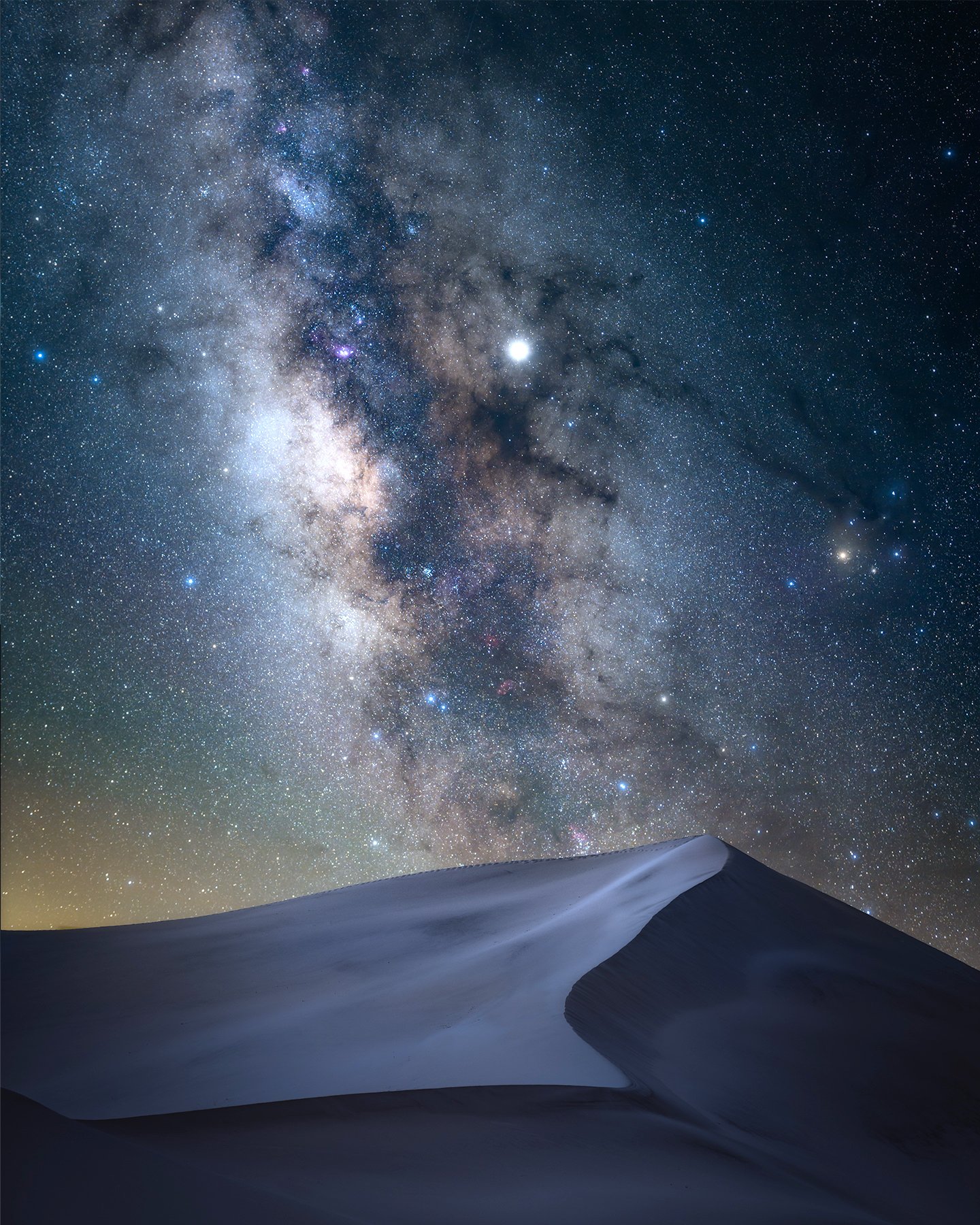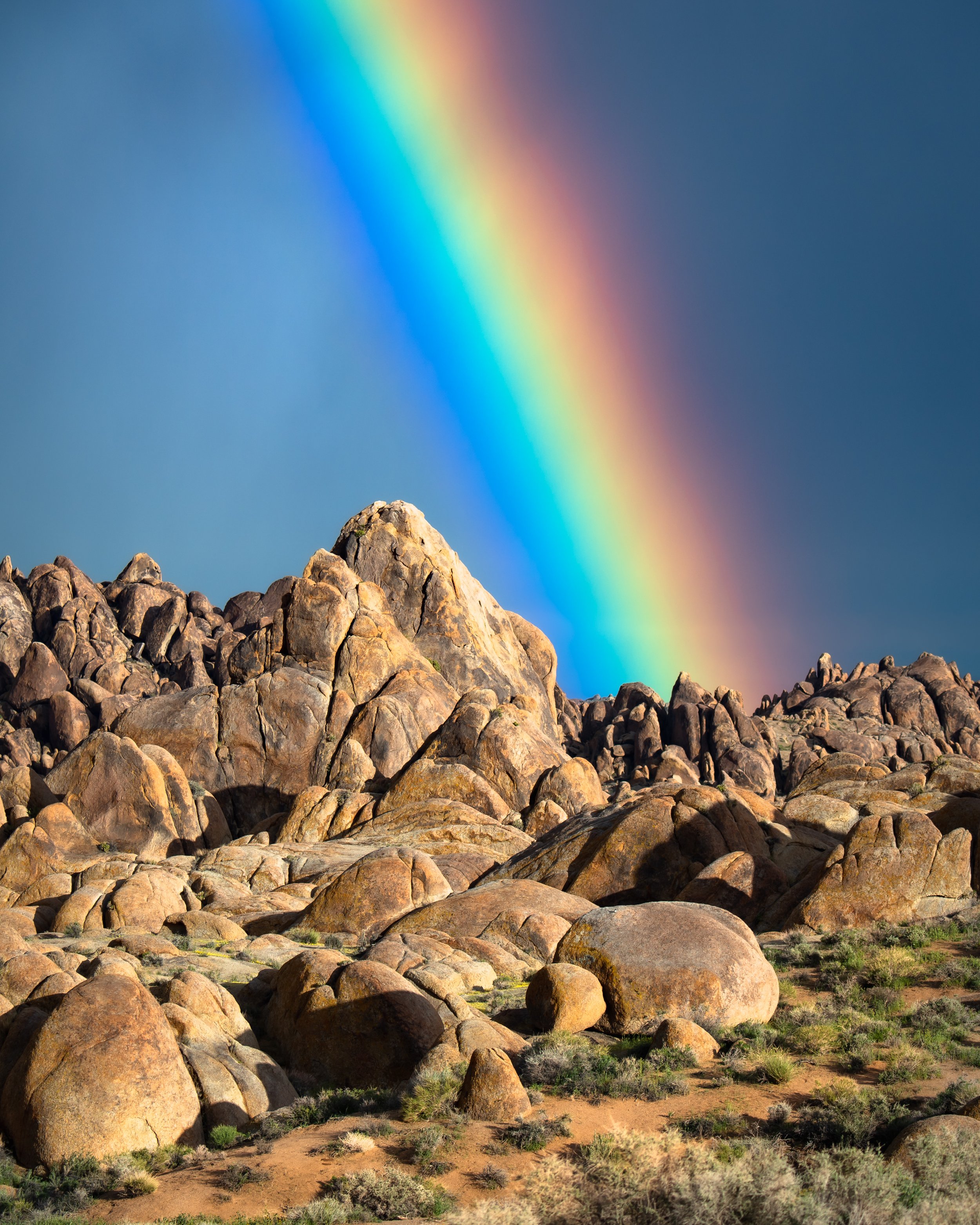
DEATH VALLEY & BEYOND 2026
6-Day Milky Way & Landscape Photography Workshop
March 15-20 (Sunday-Friday)
Incredible Natural Diversity Throughout this Breathtaking
Death Valley N.P. & Alabama Hills Adventure
(Small Group – Five Students)
Our small group of five will get a little dirt on the tires as we journey through some truly eye-popping locations in Death Valley and the Alabama Hills. This six-day odyssey begins amid the vast, otherworldly landscapes of Death Valley National Park and winds up in the sculpted rock formations of the Alabama Hills at the foot of the Eastern Sierra Nevada. Embark on this incredible road trip and capture the Milky Way against dramatic desert backdrops and stunning rock formations. Join us for an unforgettable adventure under the stars and beyond, where each night’s sky offers a new canvas and each sunrise reveals another world.
FEATURES OF THIS TRIP
WHERE WE WILL TRAVEL
Death Valley National Park
Death Valley National Park is known for its resonating beauty despite its harsh and unforgiving environment. The park straddles the California–Nevada border, east of the Sierra Nevada, and occupies an interface zone between the arid Great Basin and Mojave deserts, protecting the northwest corner of the Mojave Desert and its diverse environment of salt-flats, sand dunes, badlands, valleys, canyons and mountains. Death Valley is the largest national park in the contiguous United States, as well as the hottest, driest and lowest of all the national parks in the United States. The park is home to many species of plants and animals that have adapted to this harsh desert environment including creosote bush, Joshua tree, bighorn sheep, and coyote. It’s sand dunes, cracked mud, salt flats, and myriad other natural attractions make this a photographer’s paradise. We will visit the park for three full days, featuring nightscape photography (weather permitting.) The historic Amargosa Opera House will make for our base of operations during the three nights of this first leg of our trip, and I am confident that you will agree, this place is a destination unto itself.
6 Things You may not Know About Death Valley N.P.
At more than 3.4 million acres, Death Valley National Park is the largest national park in the Lower 48
The highest recorded temperature in the world was recorded in Death Valley’s Furnace Creek at 134 Fahrenheit in July 1913
Death Valley is the driest place in the country, and in 1929, there was not a single drop of rain recorded in Death Valley
Death Valley is home to the country’s lowest point, Badwater Basin, which lies at 282 feet below sea level
Death Valley is only 76 miles from the highest point in the country, Mt. Whitney, which tops out at an elevation of 14,505 feet. In other words, the lowest and highest points in the contiguous U.S. are less than 100 miles apart!
Life abounds in Death Valley! The Park is home to more than 1000 species of plants (including 50 that are found nowhere else in the world), 300 species of birds, 51 species of mammals (including bighorn sheep and mountain lions), 36 species of reptiles and even amphibian and fish species
WHERE WE WILL TRAVEL
Alabama Hills
The Alabama Hills is located north-west, and just under two hours from Death Valley. The Alabama Hills are a range of hills and rock formations near the eastern slope of the Sierra Nevada in the Owens Valley, west of Lone Pine in Inyo County, California. Though geographically separate from the Sierra Nevada, they are part of the same geological formation. The smooth stone formations and arches of the hills against the stunning backdrop of Mount Whitney shrouded in snow, will make exploration and composition finding exhilirating at this time of year. The Alabama Hills were named for the CSS Alabama, a Confederate warship deployed during the American Civil War. When news of the ship's exploits reached prospectors in California sympathetic to the Confederates, they named many mining claims after the ship, and the name came to be applied to the entire range.
Before You Book Your Trip,
Sign Up with the K-Group for FREE
It Will Save You Money on This Workshop!
Allow Me to Introduce Myself
It is my privilege to share with you my knowledge of photography, which was instilled during my childhood by my late father and mentor, Lowell Anson Kenyon, Chief of the Office of Photography for the Smithsonian Institution.
My style is upbeat, and enthusiastic, and l provide a positive learning environment that nurtures your art, and grounds you in best practices through personalized instruction. My tips and time-tested techniques will help you pursue your brand of photography with greater purpose and with more intentional creativity.
I hope to share with you my passion, not only for capturing compelling photographs, but also for allowing yourself to be “captured” by the beauty and awe of this place – to connect with nature, and appreciate the relevance of our great western treasures.
These workshops are adventurous, and you will enjoy maximum time in the field.
There is no arguing that golden hour light is wonderful, but you will also learn how to maximize any lighting scenario, simply because we don’t always have the luxury of creating images in golden hour, or under perfect light for that matter. You will also be encouraged to use all of your lenses, whether that be a macro for Autumn still life compositions, or a telephoto to capture intimate landscape details otherwise far from view. Remember, you can always rent lenses if you don’t already own them.
To ensure you receive a well-rounded educational experience, following this workshop, I provide you with two-hours of HD video content from my Digital Darkroom series. The series is suitable for all skill levels in post processing, and use both Adobe Lightroom and Photoshop. If you are uncomfortable with Photoshop, please know there will be content processed solely in Lightroom.
So join me on Death Valley & Beyond, where filling you with memories is as important as filling your memory cards with unforgettable images.
Trip Overview
Prepare to dive into the raw beauty of Death Valley and Alabama Hills. From towering dunes to rugged rock formations, this adventure promises star-filled nights and breathtaking landscapes, so get ready for an epic journey that blends the craft of photography, exploration, and unforgettable memories.
-
Workshop Snapshot
DATES: March 15-20, 2026 (Sunday-Friday) Concluding after sunrise on Friday
PRICE PER PERSON: $2,995 (six days/five nights) Deposit of $1,500 to hold your place, with final payment due approximately 120 days prior to the trip.
GROUP SIZE: Limit 5 Students
PHOTOGRAPHY LEVEL: Beginner-Advanced
TERRAIN: Gradual slopes, sandy, sand dunes, uneven and rocky terrain
ALTITUDE: • Death Valley: Sea level • Alabama Hills: 5,350’
ACTIVITY LEVEL: Moderate activity with treks under two miles, sandy, rocky
CLIMATE: Avg. Daytime temps: 78-82˚–– Avg. Nightime temps: 50-55˚
NEAREST TOWN(S): Lone Pine (near Alabama Hills) Amargosa (due east of Death Valley)
AIRPORT(s): Las Vegas McCarren Int’l
VEHICLE: All locations are accessible by stock, high-clearance, four-wheel drive vehicles
ACCOMMODATIONS: Recommended accommodations included Amargosa Hotel and Opera House for Death Valley and Dow Villa Motel in Lone Pine (Alabama Hills). Please be sure to make your hotel reservations at the time of booking this trip to ensure room availability.
Itinerary SnapshotTRIP VITALS: We will begin with a Meet & Greet at Amargosa Opera House and Hotel on Sunday, 3/15, at 2:00 p.m. We spend three days (3/15-18) in Death Valley, and then head to the Alabama Hills on Wednesday (3/18), our new base of operations in Lone Pine, at the historic Dow Villa Hotel. The remaining two days will be spent in the Alabama Hills. On Friday morning, 3/20, we will wrap things up, and say our goodbyes after shooting sunrise, and if you don’t have to run to catch your flight, enjoy breakfast together in Lone Pine.
SHOOTING SCHEDULE: Our featured locations are not far from our accommodations. Be sure to dress for the temps (it will be cold), bring snacks, and stay hydrated! Detailed itinerary is emailed to you approximately 30 days prior to our start date.
LODGING: Death Valley: Amargosa Opera House; Lone Pine (Alabama Hills): Dow Villa Motel
Astronomical Snapshot (approximate)MORNING
Blue Hour: 7:27 a.m. - 7:37 a.m.
Golden Hour: 7:37 a.m. - 8:26 a.m.
Sunrise: 7:52 a.m.EVENING
Golden Hour: 7:24 p.m. - 8:13 p.m.
Sunset: 7:58 p.m.
Blue Hour: 8:13 p.m. - 8:23 p.m.
Milky Way: 3:15 a.m. - 6:24 a.m.
DEATH VALLEY & BEYOND 2026
March 15-20 (Sunday-Friday)
Six Day Landscape and Milky Way Photography Workshop
$2,995 (See Trip Details for lodging recommendations)
(Only a deposit required if booked 120+ days in advance)
FAQ
-
This Workshop Includes
I love sharing my knowledge of photography, and I trust these amazing places will inspire you. So come and enjoy an exciting, educational, and fun western adventure, all the while knowing that I am there to guide you through each photographic opportunity.
PLEASE NOTE:We will schedule apre-trip Zoom meeting approximately 30 days prior to the workshop start date
Workshop Instruction to IncludeI will guide you through my workflow in the field, the art of approaching the scene, compositional techniques, scouting and strategy, and some creative philosophy to help you elevate your photography to new heights. From scouting and planning using my recommended phone apps, to my complete Milky Way workflow in the field, you will come away equipped with the knowledge, creative insight, and practical applications to achieve your goals.
Instructional Nightscape Guide
You will receive, via email, my “Capture the Night” guide to nightscape photography (PDF). This guide will review camera setup and settings that optimize your photography for both daytime and night photography.
Digital Darkroom InstructionAt no additional charge, each workshop includes a two-hour post processing Zoom session for the group in approximately two to three weeks following the trip. All attendees are encouraged to attend, as we will go through my Milky Way blue-hour-blend workflow. Every effort will be made to accommodate your schedule when we schedule our session. Should you be unable to attend, you will receive an email with the link to an HD video download of the session.
-
What to Bring
GEAR
Camera: DSLR or mirrorless with a wide aperture (i.e., f/2.8 or wider) lens.
Lenses: Wide angle: 14-24mm, Mid-range: 24-70mm, Telephoto: 70-200mm, 80-400mm, etc.(as noted in full frame focal lengths)
Solid tripod and head
Wired shutter release or wireless remote release, for long bulb-mode exposures (if camera is not equipped)
Extra batteries for everything that takes batteries. You’ll thank me.
Extra memory cards, so you don’t miss a single shot
Lens cleaner/blower to save you from dust gremlins
Circular Polarizer (if you only have one filter in your bag, this is it)
3-stop or variable neutral density (nice to have, but not required)
Laptop, or other system to backup your images each day
PERSONAL
Headlamp (did I say bring extra batteries?)
Camera bag + rainfly (yes, even in the desert)
Bring layered, warm, breathable, clothing, including a waterproof shell
Comfortable supportive footwear, wicking socks (wool or synthetic) (keep your feet happy)
Dress for the temps. Layers are recommended. Always check the local forecast as it varies.
Bring snacks and stay hydrated (hydration especially important at altitude)
Consider hand warmers for those early morning shoots, plus warm gloves or fingerless mittens
Trekking poles (better safe than sorry)
Bug repellant (highly recommend Picaridin by Sawyer for the local DEET-resistant night gnats)
Sun Glasses, hat, handkerchief (Desert sand especially hard on the eyes, handkerchief for dusty wind)
Toiletries
-
This Workshop Does Not Include
No ground transportation, or transportation to or from the workshop.
No food/beverages will be provided
There is no insurance provided to cover your travel, trip, your gear, or your vehicle. (Trip insurance is recommended)
No camera gear is provided
There may be little or no cellphone coverage in the workshop locations
-
Requirements
You are responsible for knowing your way around your camera and its menu system. My time with each of you will be spent learning to capture great images. Please do not burden others, and get less out of this event yourself – know and practice your camera, especially if you will be using any new gear on this trip.
Ability to shoot in a variety of weather and environmental conditions from bright sun to summer storms and at elevations ranging from near sea level to over 10,000 feet in elevation, depending on the workshop.
The ability to hike one to two miles per day over uneven, hilly, and at times rough terrain, however, most locations do not involve much hiking at all.
The ability to remain flexible to make the most out of the often changing environmental conditions.
The ability to work well with others in a group setting.
Our group must stay together. Please do not wander off without telling me of your where abouts. We will be in areas with potential hazards that include exposed cliffs, unstable terrain, and wildlife.
You are responsible for knowing and following all park or jurisdictional rules. Leave No Trace. Let’s leave it better than it was! Thank you!
-
With Christine Kenyon's unmatched cancellation policy, your workshop investment remains secure and flexible. If you're unable to attend, you may receive a refund (if your seat is filled), or apply your payment as a credit toward future workshops for up to two years—giving you peace of mind and full control over your plans.
Refunds and Credits
Should you cancel your trip for any reason, you will receive a full refund, minus a $250 cancellation fee, provided your seat can be filled prior to the workshop commencing. However, there is no guarantee that your seat will be filled.
If your seat cannot be filled, your deposit (for non-custom group workshops only) may be applied as a credit toward another workshop within the same calendar year, minus a $250 cancellation fee, provided a seat is available. If any portion of your credit remains unused, up to 50% of the balance may be carried over for use in the following year. All remaining credit expires after that time. Should the credit be used toward a workshop of greater value, you are responsible for the difference.
In the event of more-than-one cancellation within the two-year credit window, all remaining credit, including any additional payments toward the second cancellation, will be forfeited. We strongly encourage clients to confirm availability and commitment before rescheduling.
All workshops purchased using a cancellation credit are not eligible for any other discount. After the credit is applied to a new workshop, the remaining balance due is to be paid in accordance with the standard trip payment schedule.
Should cancelling a workshop, at any time prior to its commencement, result in Christine Kenyon incurring any nonrefundable costs or fees (i.e., group accommodations, AirBNB, third party bookings, etc.), Christine Kenyon will deduct these costs from any existing credit applicable toward future bookings.
Cancellation requests must be made in writing - via mail or email. No refunds will be given for any delays or cancellations for reasons of inclement weather, cancelled or delayed flights, or other events/disasters, acts of God, or for any circumstance beyond Christine Kenyon’s control, either before, during, or after the workshop.
Trip/travel insurance is highly recommended, and a reference can be provided.




















